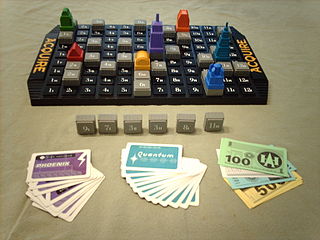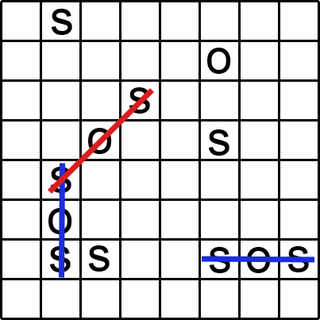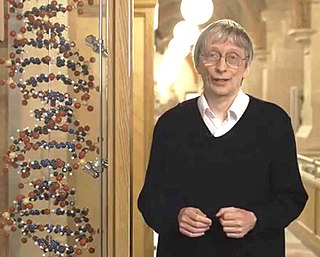
Acquire is a multi-player mergers and acquisitions themed board game. It is played with tiles representing hotels that are arranged on the board, play money and stock certificates. The object of the game is to earn the most money by developing and merging hotel chains. When a chain in which a player owns stock is acquired by a larger chain, players earn money based on the size of the acquired chain. At the end of the game, all players liquidate their stock in order to determine which player has the most money. It was one of the most popular games in the 1960s 3M bookshelf game series, and the only one still published in the United States.

Tic-tac-toe, noughts and crosses, or Xs and Os is a paper-and-pencil game for two players, X and O, who take turns marking the spaces in a 3×3 grid. The player who succeeds in placing three of their marks in a horizontal, vertical, or diagonal row wins the game.

Hex is a strategy board game for two players played on a hexagonal grid, theoretically of any size and several possible shapes, but traditionally as an 11×11 rhombus. Players alternate placing markers or stones on unoccupied spaces in an attempt to link their opposite sides of the board in an unbroken chain. One player must win; there are no draws. The game has deep strategy, sharp tactics and a profound mathematical underpinning related to the Brouwer fixed-point theorem. It was invented in the 1940s independently by two mathematicians, Piet Hein and John Nash. The game was first marketed as a board game in Denmark under the name Con-tac-tix, and Parker Brothers marketed a version of it in 1952 called Hex; they are no longer in production. Hex can also be played with paper and pencil on hexagonally ruled graph paper.

The Game of Life, also known simply as Life, is a cellular automaton devised by the British mathematician John Horton Conway in 1970.

Mastermind or Master Mind is a code-breaking game for two players. The modern game with pegs was invented in 1970 by Mordecai Meirowitz, an Israeli postmaster and telecommunications expert. It resembles an earlier pencil and paper game called Bulls and Cows that may date back a century or more.
A Gamut of Games is an innovative book of games written by Sid Sackson and first published in 1969. It contains rules for a large number of paper and pencil, card, and board games. Many of the games in the book had never before been published. It is considered by many to be an essential text for anyone interested in abstract strategy games, and a number of the rules were later expanded into full-fledged published board games.

Eleusis is a multi-genre card game where one player chooses a secret rule to determine which cards can be played on top of others, and the other players attempt to determine the rule using inductive logic.
The Shannon switching game is an abstract strategy game for two players, invented by American mathematician and electrical engineer Claude Shannon, the "father of information theory" some time before 1951. Two players take turns coloring the edges of an arbitrary graph. One player has the goal of connecting two distinguished vertices by a path of edges of their color. The other player aims to prevent this by using their color instead. The game is commonly played on a rectangular grid; this special case of the game was independently invented by American mathematician David Gale in the late 1950s and is known as Gale or Bridg-It.

In a cellular automaton, a Garden of Eden is a configuration that has no predecessor. It can be the initial configuration of the automaton but cannot arise in any other way. John Tukey named these configurations after the Garden of Eden in Abrahamic religions, which was created out of nowhere.

A hex map, hex board, or hex grid is a game board design commonly used in wargames of all scales. The map is subdivided into a hexagonal tiling, small regular hexagons of identical size.
Haggle is a party game designed by Sid Sackson and intended for a large number of players. It is rather complex and involved compared to many party games and, as a result, is often played only at gatherings of people who are known to enjoy gaming at other times.

Surakarta is a little-known Indonesian strategy board game for two players, named after the ancient city of Surakarta in central Java. The game features an unusual method of capture which is "possibly unique" and "not known to exist in any other recorded board game".

SOS is paper and pencil game for two or more players. It is similar to tic-tac-toe and dots and boxes, but has greater complexity.

Purble Place is a suite of three computer games for children and teenagers. Developed by Oberon Games for Microsoft, it was introduced in Windows Vista and also is included in Windows 7.
mi×ma+h is a Canadian board game developed by Wrebbit and published in 1987. It resembles a variant of Scrabble in that tiles are placed on a crossword-style grid, with special premiums such as squares that double or triple the value of a tile and a 50-point bonus for playing all seven tiles on the player's rack in one turn. Unlike Scrabble, Mixmath uses numbered tiles to generate short equations using simple arithmetic. Wrebbit, maker of Puzz-3D jigsaw puzzles, has since been taken over by Hasbro, and it appears that Mixmath has been discontinued.

Blue and Gray is a strategy board game for two players invented by Henry Busch and Arthur Jaeger in 1903. They obtained a patent for the game, but may never have published it. Blue and Gray was featured in the book A Gamut of Games (1969) by Sid Sackson. It was also featured in The Book of Classic Board Games (1991) by Klutz Press under the name Cats and Dogs. In this book, the game was ranked among the top 15 board games of all time, including checkers, backgammon, Go, and mancala. The game is also known as Wild West, Thumps Game, and Captain and Soldiers. The name Blue and Gray "refers to the uniforms of the South and the North in the Civil War and in the original game the playing pieces of the contestants were of those colors."

Lech Andrzej Pijanowski was a Polish film critic, broadcaster, director, screenwriter and populiser of games.
Minesweeper is a single-player puzzle video game. The objective of the game is to clear a rectangular board containing hidden "mines" or bombs without detonating any of them, with help from clues about the number of neighboring mines in each field. The game originates from the 1960s, and has been written for many computing platforms in use today. It has many variations and offshoots.
Panel Quiz Attack 25 is a game show airing once weekly on the Asahi Broadcasting Corporation network in Japan. The program first aired on April 6, 1975.














